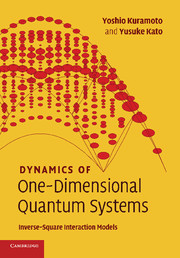Preface
Published online by Cambridge University Press: 12 January 2010
Summary
This book is concerned primarily with the exact dynamical properties of one-dimensional quantum systems. As a crucial property of exactly soluble models, we assume that the interaction decays as the inverse square of the distance. The family of these models is called the inverse-square interaction (1/r2) models. In the one-dimensional continuum space, the model is often referred to as the Calogero–Sutherland model. In the one-dimensional lattice, on the other hand, the first 1/r2 models appeared as a spin model, which is now called the Haldane–Shastry model. Soon after the discovery of the Haldane–Shastry model, it was recognized that the imposition of supersymmetry allows the model to acquire the charge degrees of freedom, while keeping the exactly soluble nature. The resultant one-dimensional electron model is called the supersymmetric t–J model. Various generalizations of these models have been proposed.
Recent experimental progress in quasi-one-dimensional electron systems, especially by neutron scattering and photoemission spectroscopy, has enhanced the theoretical motivation for exploring the dynamics over a wide frequency and momentum range. The 1/r2 models are ideally suited to meet this situation, since the model allows derivation of exact dynamical information most easily and transparently. In spite of the special appearance of the 1/r2 models, the intuition thus obtained contributes greatly to understanding low-dimensional physics in general. This kind of approach to dynamics is complementary to another powerful approach using the bosonization and conformal field theory. The latter is especially suitable to asymptotics of correlation functions at long spatial and temporal distances.
- Type
- Chapter
- Information
- Dynamics of One-Dimensional Quantum SystemsInverse-Square Interaction Models, pp. xi - xiiPublisher: Cambridge University PressPrint publication year: 2009

